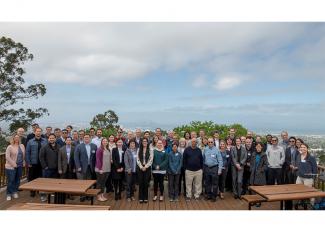Over the last 10 years, the NETL-led National Risk Assessment Partnership (NRAP) has built industrial confidence and worked to accelerate the commercial deployment of large-scale geologic carbon storage (GCS), which will allow for the continued use of abundant fossil fuels in an environmentally responsible manner by safely and permanently storing carbon dioxide from industrial sources deep underground. Now well into its second phase, NRAP is expanding its award-winning toolset and forging new collaborations that will continue to improve the initiative’s ability to address critical questions of GCS risk management.
Past NRAP research established approaches and frameworks to understand and predict the interaction of carbon dioxide in the subsurface and build confidence in these predictions. To ensure the practical utility of these products NRAP researchers are engaging with new carbon storage partnerships like the U.S. Department of Energy’s (DOE) Regional Initiatives, industry, state and federal regulators and academia to improve computational tools and workflows to better address critical questions of risk management for geologic carbon storage sites.
Working toward this goal, NRAP’s Phase II efforts, which began in 2017, include the development of new and improved tools and methods used to obtain vital information about the complex nature of carbon dioxide (CO2) storage sites. Researchers are investigating containment assurance, induced seismicity risk management, strategic monitoring for system diagnosis and uncertainty reduction, and applying and validating risk assessment tools and methodologies using synthetic and field data. These tools can be used to address a variety of stakeholder questions as they make risk performance-related decisions throughout the GCS project life cycle. A brief description of each NRAP Phase II risk assessment tool follows.
- NRAP-Open-IAM – An open source platform to simulate long-term, full-system behavior (reservoir to aquifer/atmosphere) of GCS sites and support decision-making amidst uncertainties.
- Short-term Seismic Forecasting Tool – Uses site-specific catalogs of measured seismicity to forecast future event frequency over the short term.
- State-of-Stress Analysis Tool – Embodies a Bayesian approach to calculate a distribution of in situ stress at specific locations at a GCS site based on commonly used measurements or relationships and then estimates the probability of activating a critically oriented fault over a specified range of pore pressures.
- RiskCat – A probabilistic seismic risk analysis general purpose computational framework and application for GCS sites.
- Designs for Risk Evaluation and Management (DREAM) version 2.0 – NRAP’s next-generation leakage monitoring design and optimization at GCS sites.
Numerous U.S. and international studies have described tests and verification of NRAP tools and methodologies including several focused on applications at DOE-funded carbon storage sites like the CarbonSAFE projects sites; the FutureGen 2.0 site in Decatur, Illinois; and other candidate GCS storage sites and relevant natural analog sites. These case studies provide useful examples of the utility of the tools and serve as method validation to ensure relevance to the NRAP tool user community.
These tools and approaches support site selection, design, permitting and closure decisions, reduce uncertainty, and build public confidence that GCS storage can be done safely and effectively. NRAP is helping the Carbon Storage Program to gain important technical insights to support assertions that subsurface risks from appropriately selected and well-operated GCS sites are quantifiable, acceptably small and manageably decrease after injection operations cease.
While the NRAP project has made significant advancements, important technical objectives are still being realized. Through the end of NRAP Phase II (expected completion 2022), researchers hope to further develop the capabilities of the NRAP-Open-IAM tools to make them more useful and usable to key stakeholders. This will require continued engagement with stakeholders to test and apply the NRAP tools and risk management workflows, and incorporation of learning from those applications to refine tool functionality.
NETL leads the NRAP initiative, which draws from the expertise of four additional contributing national laboratories — Lawrence Berkeley National Laboratory, Lawrence Livermore National Laboratory, Los Alamos National Laboratory and Pacific Northwest National Laboratory. Together, the NRAP team comprises international leaders in advancing the science and engineering of engineered geologic systems.




